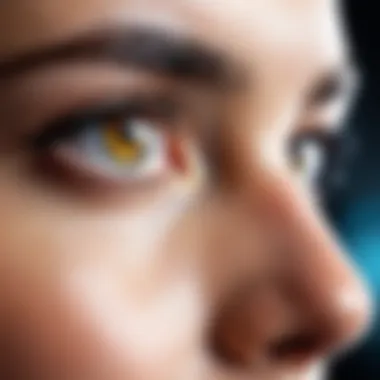Mastering Background Blur Techniques in Photography


Intro
In photography, background blur enhances the focus on the main subject. This technique, often referred to as bokeh, not only elevates the composition but also adds a professional touch. Understanding how to achieve this effect can transform your images from mundane to visually appealing. This article delves into various methods for creating background blur, examining both hardware and software options, along with post-processing techniques.
Key Features
Optics and Aperture Settings
A significant factor contributing to background blur is the lens aperture. A wider aperture (smaller f-number) creates a shallower depth of field. This means that only a small part of the image is in sharp focus, effectively blurring the rest. Lenses such as the Canon EF 50mm f/1.8 or the Nikon 85mm f/1.8 are commendable for their abilities to create pleasing bokeh. When selecting lenses, consider the following:
- Aperture Size: Wider apertures allow better blur effects.
- Focal Length: Longer focal lengths yield more pronounced background blur.
Sensor Size
Sensor size plays a crucial role in determining depth of field. Larger sensors, like those in full-frame cameras, capture more light and provide shallower depth of field compared to crop sensors. This difference is vital when aiming for that exquisite bokeh effect.
Subject Distance
The distance between the subject and the background also impacts the blur. The further the background is from the subject, the more pronounced the blur becomes. For instance, isolating your subject from a cluttered background will enhance the bokeh effect significantly.
Software Techniques
Editing Platforms
Post-processing software such as Adobe Lightroom and Photoshop allows photographers to manipulate depth of field digitally. Using the following techniques:
- Lens Blur Filter in Photoshop: Simulates the look of a shallow depth of field by blurring certain areas of the photo.
- Selective Focus in Lightroom: Create a radial filter or gradient mask to soften a background while keeping the subject sharp.
"The power of editing tools expands the creative possibilities for achieving stunning background blur."
Mobile Editing Apps
For those using smartphones, apps like Snapseed and Afterlight provide options to blur backgrounds effectively. These tools make it more accessible for casual users to achieve professional-like results without extensive photography equipment.
The End
Mastering background blur in photography requires a good understanding of both hardware and software techniques. Each method contributes uniquely toward creating depth in images, guiding the viewer’s eye to the subject effectively. By leveraging aperture settings, sensor sizes, and editing tools, photographers can enhance their skills and transform their visual storytelling.
Understanding Background Blur
Background blur, often referred to as bokeh, plays a crucial role in photography, enhancing the focus on the primary subject while reducing distractions from the background. This technique holds significant importance as it elevates the overall aesthetic of an image. Using background blur effectively can transform an ordinary photo into a captivating visual experience.
Definition and Importance
Background blur can be defined as the deliberate softening of elements behind the main subject in a photograph. This effect is created through specific camera settings and techniques. Understanding this concept is key for any photographer who aims to achieve a professional look.
The importance of background blur extends beyond mere aesthetics. It helps in concentrating the viewer's attention, ensuring that the subject stands out. This is especially valuable when shooting in environments rich in detail, where competing elements can easily divert focus. Blur assists in creating depth, which adds a three-dimensional feel to otherwise flat images.
Moreover, the choice of background blur can influence the emotional impact of a photo. Certain blur techniques evoke feelings of serenity or intimacy, while others may create a sense of mystery or nostalgia. Recognizing these possibilities allows photographers to convey deeper narratives through their work.
Creative Uses of Background Blur
The creative potential of background blur is vast. Photographers can utilize this technique across various genres, from portraiture to landscape photography. In portrait shots, a well-executed background blur diminishes distractions, allowing viewers to connect more intimately with the subject. This draws attention to facial expressions and emotions that might otherwise go unnoticed.
In macro photography, where minute details are captured, background blur serves to isolate the subject, emphasizing intricate textures and colors. Similarly, in events like weddings or parties, blur can enhance candid moments by allowing the background to fade while keeping the primary subjects sharp.
Another innovative approach involves using background blur in product photography. Here, isolating the product from its environment can create a striking contrast that attracts potential buyers’ focus. It can also help in communicating brand identity by controlling which elements appear in the image.
Camera Settings for Background Blur
Effective camera settings are fundamental when aiming for background blur in images. They play a crucial role in determining how your image will look and what artistic effects can be achieved. Understanding the relationship between these settings can result in improved focus on your subject while reducing distractions in the background. Different techniques can utilize camera settings to create a specific atmosphere, highlight details, and lead the viewer's eye toward intended focal points.
Aperture Control
Understanding f-stop
The f-stop is a critical component in defining the aperture of a camera lens. It determines the amount of light entering the camera and also affects the depth of field. A lower f-stop number (like f/2.8) corresponds to a wider aperture, allowing more light in and effectively producing a narrow depth of field. This characteristic is essential for achieving that sought-after background blur, as it isolates the subject from the surroundings. It is popular among photographers who want to create a pronounced focus on the subject while letting the background fade elegantly.
However, there are disadvantages. Using a low f-stop can lead to a softer focus on the subject, particularly at very close distances. Maintaining sharpness and detail requires skill in controlling the focus plane.
Effects of wide vs. narrow apertures


Choosing between a wide or narrow aperture has direct implications on the depth of field. A wide aperture not only allows for significant light intake but also enhances background blur, making the area behind the subject appear softer and less distracting. For portrait photography, this effect is desirable, as it emphasizes the subject's features while placing less visual weight on the background.
Conversely, a narrow aperture (like f/11) results in greater depth of field. This setting keeps both subject and background in focus, which is typically not favorable for achieving artistic background blur. However, it can be beneficial for landscape photography where detail throughout the frame is important. Thus, the and effective decision on aperture settings depends on the desired outcome of your photography.
Shutter Speed and ISO
Shutter speed and ISO settings also contribute significantly to achieving the desired background blur. Shutter speed controls the duration for which the camera sensor is exposed to light. Fast shutter speeds can freeze motion, while slow speeds allow for motion blur. For portrait photography where background blur is desired, using a moderate shutter speed along with proper aperture can effectively lead to beautiful images without moving blur disturbance.
ISO, on the other hand, dictates the camera sensor's sensitivity to light. A high ISO can work in tandem with wide apertures, allowing for shooting in low-light conditions while still creating background blur. However, increasing ISO can introduce noise into images. Therefore, balancing these settings with attention to lighting conditions is essential.
Utilizing camera settings properly can greatly enhance the quality and aesthetics of images. These tools combine to create a photographic landscape where the subject is engagingly separated from an intentionally blurred background.
Lens Selection for Optimal Blur
Selecting the right lens is crucial for achieving a pleasing background blur. The lens you choose affects not only the amount of blur but also the quality and aesthetics of that blur. The advantages of proper lens selection are significant, especially when aiming to create a visually engaging photograph. Different lenses offer unique characteristics that can enhance your subject and overall composition.
Prime vs. Zoom Lenses
When considering lenses, a primary distinction arises between prime and zoom lenses. Prime lenses have a fixed focal length, which generally results in better image quality and wider maximum apertures. This allows for a shallower depth of field, emphasizing the subject while beautifully blurring the background. An example of this is the Canon EF 50mm f/1.8, known for its sharpness and excellent bokeh.
In contrast, zoom lenses offer versatility with multiple focal lengths. While they may not provide the widest apertures available in prime lenses, many modern zooms like the Nikon AF-S NIKKOR 24-70mm f/2.8E can also create impressive background blur. The advantage of a zoom lens lies in its flexibility, enabling quick adaptations to various shooting situations without changing equipment. However, remember that the trade-off may include slight reductions in sharpness and overall image quality, especially at the extremes of their focal lengths.
The Role of Focal Length
Focal length plays a significant role in generating background blur. Longer focal lengths naturally compress the distance between the subject and the background, effectively separating them visually. For instance, a telephoto lens like the Sony FE 85mm f/1.8 can achieve a pronounced blur, making it ideal for portrait photography.
On the other hand, shorter focal lengths produce a wider field of view. While they can still create background blur, the effect may not be as pronounced. An 18mm lens, for example, can minimize blur compared to an 85mm lens. That is why, when selecting a lens, considering the distance from the subject and the background is essential along with the focal length.
"Choosing the right lens not only influences background blur but also impacts the entire visual narrative of your image."
In summary, lens selection involves understanding the distinctions between prime and zoom lenses while recognizing the significance of focal length. This knowledge equips photographers to make informed choices, enhancing their ability to craft stunning images with captivating background blur.
Shooting Techniques for Background Blur
The ability to create a pronounced background blur in photography significantly enhances the visual impact of an image. It guides the viewer's attention directly to the subject, creating a sense of depth and professionalism. Mastering shooting techniques is crucial for anyone looking to elevate their photography. Understanding how to manipulate distance, both from the subject and the background itself, plays a vital role in achieving the desired bokeh effect.
Distance from Subject
The distance between the camera and the subject is paramount. When you position the camera closer to the subject, you increase the potential for background blur. The closer proximity helps create a shallower depth of field, which enhances the separation between subject and background. This is particularly effective in portraits or close-up shots, where the intent is to highlight specific details.
In practical scenarios, this technique may simply involve moving in closer to your subject or adjusting your stance. However, it's also worth considering your lens choice. For example, a macro lens allows for extreme close-ups, providing even more pronounced blur. This technique is akin to focusing on an object while diminishing what is around it. Therefore, whenever you consider your composition, factor in your distance from the subject to achieve optimal results.
Background Distance
An equally important aspect is the distance of the background from the subject. The farther the background is from your primary focus, the more pronounced the blur will be. This creates a liquefied or softening effect that enhances the subject’s clarity and presence. It is crucial to plan your shots in environments where the background has sufficient space from the subject.
Utilizing this technique can also involve strategic framing. For instance, if shooting outdoors, choosing locations with depth can significantly alter your composition. Following this, consider the placement of elements in the background to avoid distractions that could detract from the subject.
The synergy of subject and background placement dictates the overall effectiveness of your background blur.
By mastering these shooting techniques, photographers can produce images that not only stand out but also convey a more profound narrative. The interplay between distance from the subject and the background is fundamental to achieving an aesthetically pleasing photograph.
Using Depth of Field Effectively
Using depth of field effectively is an essential technique in photography that can greatly enhance the quality of your images, especially concerning background blur. Depth of field refers to the zone of acceptable sharpness within an image. Mastering this concept allows photographers to isolate subjects from their backgrounds, creating a distinct separation that draws the viewer's eye where it needs to go.
By understanding depth of field, photographers can manipulate the sharpness of various elements in an image. This skill not only emphasizes the subject but also allows for creative storytelling, shaping how the viewer perceives the scene. The ability to control depth of field can yield different results depending on various factors, including aperture, focal length, and the distance between the subject, camera, and background.
In summary, effectively employing depth of field is about achieving that perfect balance between background blur and subject clarity, enabling photographs to convey emotion and narrative more powerfully.
What is Depth of Field?
Depth of field is defined as the distance between the nearest and farthest objects in a photo that appear acceptably sharp. Two primary factors influence depth of field: aperture and focal length. A wider aperture (i.e., a lower f-stop number) results in a shallower depth of field, creating more pronounced background blur. Conversely, a narrower aperture increases the depth of field, making more of the image sharp.
Focal length also plays a critical role in determining depth of field. Longer focal lengths tend to yield a shallower depth of field, even at smaller apertures. On the other hand, shorter focal lengths often provide a greater depth of field.
This understanding is crucial for photographers aiming to achieve specific artistic effects in their images. In practical terms, a shallow depth of field can help to eliminate distractions in the background while emphasizing the subject.
Adjusting Depth of Field
Adjusting depth of field involves deliberate choices regarding camera settings. To attain a shallow depth of field, one can:
- Use a wide aperture (e.g., f/1.8 or f/2.8).
- Choose a longer focal length, such as an 85mm or 135mm lens.
- Position the subject closer to the camera while keeping the background further away.


In contrast, if you want to achieve a greater depth of field, you should:
- Use a narrower aperture (e.g., f/8 or f/16).
- Work with a shorter focal length, such as a 24mm or 35mm lens.
- Move further away from the subject.
Adjusting depth of field is not just about technical settings; it is also a way to creatively express your photographic vision. Each adjustment impacts the viewer's experience and can guide their emotional response.
This capability to adjust depth of field is instrumental for photographers, offering them versatile tools to communicate their artistic intent. Understanding how to manipulate this element allows for more compelling images that resonate with the viewer.
Post-Processing Techniques
Post-processing techniques are essential to refining images after the initial capture. These methods allow photographers to enhance the background blur effect, further emphasizing their main subjects. In today's digital photography landscape, having the right post-processing skills can make a significant difference in the final output. This section delves into specific software tools and techniques that are pivotal in achieving professional-level results.
Using Editing Software
Effective editing software plays a crucial role in the enhancement of background blur in images. Two of the most prominent tools in this arena are Photoshop and Lightroom, each offering unique capabilities that cater to different editing styles and preferences.
Photoshop
Photoshop is well-known for its versatility and robust features. It empowers users to manipulate images on a granular level. A key characteristic of Photoshop is its layer and masking system, which provides flexibility when editing different parts of an image. This is particularly valuable when wanting to focus on enhancing background blur without altering the subject’s clarity.
A unique feature of Photoshop is the selective focus tool, which allows for precise control over which areas of an image are blurred while maintaining crispness in the subject. However, this powerful tool can be complex for beginners. This complexity can lead to a steep learning curve, which is a disadvantage for those seeking quick adjustments. Despite this, many professionals prefer Photoshop for its extensive customization options.
Lightroom
Lightroom, in contrast, provides a more streamlined approach to photo editing. Its key characteristic is the ability to batch process images, making it ideal for photographers who need to edit multiple photos efficiently. Lightroom also excels at organizing and cataloging images, which can greatly aid in workflow management.
A significant advantage of Lightroom is its clarity adjustment feature, which can enhance the subject while simultaneously allowing background blur to be refined. However, it lacks some of the detailed manipulation options found in Photoshop, which might limit advanced users seeking extensive edits. For many, Lightroom strikes a balance between simplicity and powerful features, making it a popular choice.
Applying Gaussian Blur
Applying Gaussian Blur is another effective post-processing technique. This method creates a smooth, even blur effect that can enhance background blur in images.
To apply Gaussian Blur, users can selectively choose areas of an image they want to blur. This is beneficial in isolating the main subject. It helps in eliminating distractions that might detract from the viewer's focus. By adjusting the radius of the blur, photographers can control how soft or sharp the effect appears. This flexibility allows for personal expression within the editing process.
In summary, mastering post-processing techniques is vital for anyone looking to enhance background blur in their photography. Utilizing powerful tools like Photoshop and Lightroom, along with techniques like Gaussian Blur, can dramatically elevate image quality and overall aesthetic. Understanding both the benefits and limitations of these software options can help photographers make informed decisions tailored to their specific needs.
Mobile Photography and Background Blur
Mobile photography has transcended the realm of casual snapshots. Today, the integration of advanced camera technology into smartphones ensures that photographers can create visually compelling images with relative ease. One of the pivotal techniques employed to enhance image quality is background blur, known in photographic terminology as bokeh. This effect helps in isolating the subject, thereby adding a layer of professionalism to mobile images. Understanding how to achieve this aesthetic can significantly elevate the storytelling aspect of photographs taken by smartphones.
Smartphone Camera Settings
To effectively utilize background blur with smartphones, one must be familiar with essential camera settings. Many modern smartphones provide users with manual control over settings usually reserved for professional cameras. Key settings to focus on include:
- Aperture: While most smartphones have a fixed aperture, certain models like the Google Pixel and newer iPhones allow for adjustable aperture settings in portrait mode. A wider aperture (lower f-stop number) can create a more pronounced blur.
- Focus Points: Tapping on the subject in the camera app typically adjusts focus automatically. This function is crucial because accurate focusing ensures that the intended subject remains sharp while the background appears soft.
- Software Features: Many smartphone cameras now come with specific modes designed to enhance background blur, often labeled as portrait or depth modes. These features simulate the depth of field effect that traditionally requires higher-end hardware.
By adjusting these settings or utilizing specialized modes, photographers can achieve desirable background blur. It is essential to experiment with different configurations to determine what works best for the specific model being used.
Apps for Background Blur
Software plays a significant role in mobile photography, especially in post-processing. Various applications are available that enhance the ability to manipulate background blur creatively. Some notable apps include:
- Snapseed: This app offers a lens blur tool that lets users adjust the strength and shape of the blur effect. Its user-friendly interface makes it accessible for all skill levels.
- PicsArt: Known for its all-in-one design capabilities, PicsArt features a blur tool that can effectively apply background blur to images. It includes options for adjusting the intensity of the blur, allowing for more control.
- AfterFocus: Specializing in focus effects, AfterFocus allows users to select the areas of an image to keep sharp while applying blur to the background. This app simulates a DSLR-like depth of field effect.
"With just a few taps, users can manipulate the background, altering the overall mood of their photographs."
These tools provide an excellent way for mobile photographers to elevate their work without needing extensive experience or access to advanced equipment. Experimenting with various apps allows users to discover unique styles, thereby enhancing their photographic portfolio.
In summary, mobile photography has become an accessible yet powerful medium for artistic expression. By mastering camera settings and exploring software applications, photographers can effectively achieve the desired background blur, ultimately enhancing the visual clarity and storytelling of their images.
Common Mistakes to Avoid
Understanding the common mistakes in achieving background blur is crucial for anyone looking to enhance their photography. Awareness can significantly elevate the quality of images. The right background blur can focus attention on the subject without drawing distractions. Yet, overdoing it or misapplying techniques can lead to unsatisfactory results. Here are some common pitfalls to watch out for.
Over-Blurring the Background
One major mistake that photographers often make is over-blurring the background. While the aim is to isolate the subject, excessive blur can remove context from the image. It can turn a photograph into an abstract piece, which may not convey the intended message.
Achieving a natural look is essential. When the background is blurred to the point where it becomes indistinguishable, viewers may feel disoriented. It’s vital to retain some hints of the environment in which the subject exists. This can enable storytelling and provide context. For instance, in portrait photography, a slight suggestion of the setting enhances the viewer's understanding of the subject's surroundings and adds depth to the image.
Consider this: a portrait taken in a bustling city is more impactful when the faint outline of buildings or street elements is preserved. Complete obliteration of these elements can strip the photo of its narrative power. It is suggested to aim for a balance where the background supports the subject rather than overwhelms it.
Neglecting Subject Focus


Another frequent error is forgetting to prioritize subject focus. Background blur is a tool, and it should serve to draw the viewer's gaze towards the subject. If the subject remains out of focus, the entire purpose of achieving bokeh becomes redundant.
When shooting, confirm that your focal point is sharp. Many cameras allow you to adjust the focus manually or automatically, depending on your settings. If you're using a DSLR, select the appropriate focusing method—single point for stationary subjects or dynamic for moving ones. This can prevent the subject from being lost in the blur.
Furthermore, ensure that the selected aperture and distance settings work in favor of the subject. If the settings for blur are correct but the subject lacks clarity, the image will not resonate as expected. Align your creative vision with a technical execution that highlights the subject effectively.
Key takeaway: Avoid both over-blurring and lack of subject clarity for effective background blur.
In summary, by addressing these common mistakes, photographers can significantly improve their outcomes. Elevating the focus on subjects while artfully managing background blur leads to striking images that resonate with viewers.
Balancing Blur and Clarity
Achieving an effective balance between blur and clarity is crucial in photography. When employing background blur techniques, one might inadvertently obscure essential details or distract from the subject. Hence, understanding how to create a cohesion between these two elements can augment the visual storytelling aspect of an image.
Effective background blur should not overshadow the subject. The goal is to enhance the viewer's focus rather than rob the composition of context. To achieve this, one needs to consider several factors, including the depth of field, lighting conditions, and the relationship between foreground and background.
Achieving Equilibrium
Equilibrium in photography often refers to finding the right proportion between the subject and the background. This is where the art of focus becomes paramount. Using a shallow depth of field can isolate the subject effectively, but if done excessively, it may lead to confusion about the scene's context.
Key Considerations:
- Depth of Field: Experimenting with varying apertures allows a photographer to subtly manipulate depth of field. A wider aperture (lower f-stop) can create significant blur, while a narrower aperture maintains more details in the background.
- Subject Distance: The proximity of the subject to the background influences how pronounced the blur appears. Adjusting this distance can help in finding a middle ground.
- Background Elements: Observe elements in the background before taking a shot. Distracting patterns or colors can reduce clarity and compel the viewer's attention away from the subject.
Balancing blur and clarity does not always mean a 50/50 distribution. It is more about ensuring the subject stands out without losing narrative context.
Tonal Harmony
Tonal harmony is another significant aspect to regard while balancing blur and clarity. It refers to the coherence of light and color within an image. When the colors in the background blend well or contrast appropriately with the subject, it enhances the overall composition.
Considerations for Tonal Harmony:
- Color Contrast: A well-contrasted background can make the subject pop. Using colors opposite on the color wheel can achieve this effect, but it should be balanced with background blur.
- Lighting Conditions: The quality of light can change the perception of depth and clarity. Soft light may enhance background blur without sacrificing clarity in the subject.
- Mood and Atmosphere: The tonal characteristics should resonate with the intended emotion of the composition. For instance, a warm palette might evoke comfort, while cooler tones could suggest distance.
Enhancing Visual Storytelling
The art of visual storytelling in photography involves skillfully manipulating imagery to evoke emotions and convey deeper narratives. Background blur plays a critical role in this process, guiding the viewer's focus and enhancing the overall message of the photograph. By utilizing background blur effectively, photographers can create images that do not just capture a moment but also tell a story.
In photography, clear subject emphasis becomes paramount. When the background is intentionally blurred, distractions diminish. This method allows the viewer to engage with the subject of the photograph more meaningfully. Within this context, background blur helps establish a hierarchy of information. It signals to the viewer what elements are most significant, thus shaping their understanding and experience of the image.
Moreover, by integrating background blur into images, photographers can influence the emotional tone. A soft blur can create a dreamlike atmosphere, while more aggressive blurring might convey urgency or isolation. The ability to control how the background interacts with the subject opens up many creative possibilities.
Considerations about background blur also intersect with the composition of the shot. Composing an image with an awareness of how elements in the background might contribute to or detract from a narrative is essential. Balancing sharpness and blur forms an integral part of storytelling through photography.
"Effective background blur is not just a technical adjustment; it is an essential component of visual narrative construction."
Influencing Viewer Perception
Subjectivity governs how images are perceived. Background blur can dictate viewers’ interpretations. A well-designed blur can create an archetypal focus, allowing viewers to draw on their personal experiences and emotions. When they observe a soft, blurred background, they may feel a sense of calm and tranquility, associating it with peaceful scenarios. Conversely, harsh contrasts between a sharp subject and an indistinct background may evoke feelings of tension or disconnection.
In the realm of product photography, for instance, background blur helps to isolate the product, making it the sole point of interest. The clarity of the product contrasts sharply with the blurred elements, ensuring that the viewer's perception remains focused and favorable.
Using Blur as a Narrative Tool
Blur, when used judiciously, transforms an ordinary image into a powerful narrative tool. It connotes movement, change, or fleeting moments that capture the essence of an experience. Street photography often employs this technique to impart a sense of hustle and bustle, reflecting real life’s pace.
It’s not just about aesthetics; understanding the psychological impact of blur can enhance the storytelling ability of an image. In documentary photography, for instance, a blurred background can signify that often-overlooked elements in a scene deserve attention. This encourages viewers to reflect on what might matter beyond the apparent, enhancing their engagement with the complex narratives behind a simple image.
In summary, by applying background blur thoughtfully, photographers can enhance their images' storytelling capability, enabling loaded visual communication that resonates with the audience.
Concluding Thoughts on Background Blur Techniques
Understanding background blur is a crucial component of photography that elevates the artistry of images. This technique not only enhances the focus on the subject but also creates a separation from distractions in the background. As discussed throughout this article, the methods for achieving background blur vary significantly based on equipment, settings, and post-processing techniques.
One central aspect to consider is the balance between clarity of the subject and the degree of blur. This balance requires practice and awareness of the visual story that one wishes to convey. Background blur enhances visual storytelling by directing the viewer's attention. When executed correctly, it adds depth and dimension to photographs.
Moreover, the advancements in technology have democratized access to these techniques. Whether one uses a high-end DSLR or a smartphone, effective background blur can be achieved. As individuals improve their skills, the transition from casual shooting to more deliberate photography becomes clearer.
Summary of Key Points
- Background blur is essential for separating the subject from the background.
- The techniques discussed include camera settings, lens selection, and post-processing methods.
- Properly executed background blur can enhance storytelling in photography.
- Technology has made these techniques accessible to all skill levels.
Future of Background Blur in Photography
The future of background blur in photography will likely be shaped by technological advancements. As cameras and smartphones continue to improve, automated features for achieving background blur are becoming more prevalent. For example, devices like the Google Pixel have introduced computational photography techniques that facilitate background blur in real-time.
Moreover, as software evolves, post-processing tools will become increasingly user-friendly and powerful. New algorithms may allow photographers to manipulate blur more creatively and accurately without extensive technical knowledge. Additionally, AI-driven editing tools could analyze images and suggest optimal blur levels based on the context of the photograph.
As a result, the concept of background blur will become a standard feature in photography, with new avenues for creative expression emerging. Photographers will continue to refine their approaches and integrate these advancements to achieve increasingly sophisticated effects. Understanding and leveraging these changes will be important for anyone looking to stay ahead in the photography landscape.



